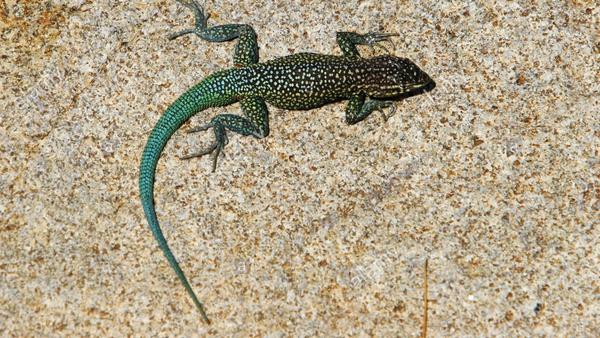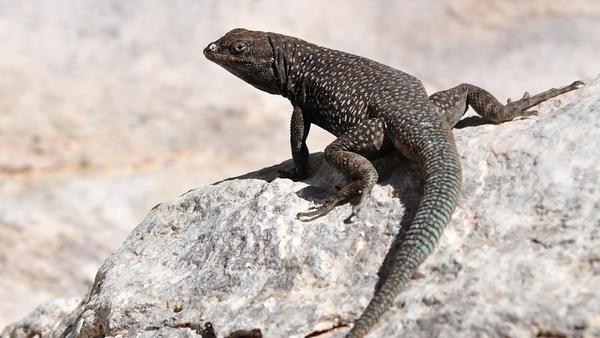What we can learn from side-blotched lizards
“It appears to me, the doing what little one can to increase the general stock of knowledge is as respectable an object of life as one can in any likelihood pursue” — Charles Darwin
Peeling back the complexities of nature to uncover underlying patterns and insights is what scientists, including community scientists, do. In that pursuit there is often a predilection to look for those rare species, those species that by their rarity are almost certainly holding on to more secrets than those common species we see every day.
My earliest foray into science was a quest to understand why rarely seen spotted owls were seemingly restricted to such large, and valuable, old-growth forests. I met my first spotted owl while taking a natural history class at UC Davis in 1976, when we came across one on a fieldtrip to an old-growth redwood forest in northwestern California. I also met Katie (my wife) in that class. Together we spent nearly a decade with these owls and we got the answers we sought. Perhaps as holdovers from the Pleistocene ice ages, spotted owls don’t like summer heat, and so wherever they occur there is some aspect of their habitat that moderates those summer temperatures. Those old growth forests have a multilayered canopy that captures much of the incoming solar radiation before it reaches the lowest canopy layers where the owls roost. It turns out they aren’t necessarily restricted to big trees, only to the cool temperatures those big trees provide. In Utah and Arizona spotted owls will occur in steep narrow canyons where the sun rarely reaches the caves in the rock walls where owls nest and roost. No need for old growth trees there.
Since those spotted owl days living in the Pacific Northwest, my interests have shifted to understanding how we humans are impacting nature. Climate change, habitat fragmentation and disturbance, invasive species. The more I thought about it the more I came to appreciate that rare species were not going to answer those questions. I needed to go beyond site-specific impacts to individuals, to look at broader impacts to populations and then species, I needed to turn my attention to common species, those same species I had overlooked for so many years. Lizards, especially common lizards, became my vehicle to answer these questions. Even the endangered Coachella Valley fringe-toed lizards are common within their sand dune habitats. They are endangered by the loss of their habitat, not by their rarity. Through fringe-toed lizards I could look at the impacts of invasive species (Sahara mustard) by measuring how their densities changed as the mustard density increased. It is a question I could have never answered with spotted owls.
Then there is the commonest of desert lizards, the side-blotched lizard, Uta stansburiana. For so many years I overlooked these small saurians; they were everywhere regardless of habitat types. What could I possibly learn from a species that does not seem to discriminate between the varied desert habitats they inhabit? The range of elevations they inhabit extend from below sea level (around the Salton Sea) to the pine and fir forests around Idyllwild, so why would they be sensitive to environmental change? But they are.
In a paper we published this year (2020) we found an ongoing shift in side-blotched lizard densities to higher elevations in Joshua Tree National Park. As temperatures and aridity are increasing, these lizards are “leaning” to higher elevations; we still find them at the lowest elevations in the park, but now their highest densities are at 1400-1600 m (4500-5000’). In the San Jacinto Mountains community scientists and I have been able to measure annual increases in their apparent high elevation limits, which are now 1900-1950 m (6000-6200’); almost every year we find them just a little bit higher up the mountain. Interestingly, according to the field guides, side-blotched lizards can occur up to 9,000’ in elevation, but they don’t say where that occurs. Certainly not in our southern California mountains, nor in Arizona, where the same field guides show them avoiding mountains above 6,000’. Maybe it is a typo that gets repeated as the field guides are updated?
So why are side-blotched lizards adapting to climate change so fast? A big part of the answer is that they have evolved to have a strategy of "live fast, die young, and leave as many offspring as local conditions (food and thermal niches) will allow." Our warm climate side-blotches rarely live more than one year, at most two years. In part that is because they put so much of their energy into reproducing regardless of the food conditions that year, and in part it’s because they are food for so many desert predators, including other lizard species. They have short generation times and so they are capable adapting (evolving) rapidly to changing conditions. Those without the best genes to survive local conditions won’t pass those genes to the next generation; those that do have the right genes produce the most hatchlings.
This rapid evolution is evident as one visits the dozens of islands in the Gulf of California, between Baja California and mainland Mexico. Each island that remained an island during the ebb and flow of sea level changes during the multiple glacial periods of the Pleistocene era now has its own species of side-blotched lizard. Some are “giants," nearly the size of a zebra-tailed lizard (Uta palmeri on Isla San Pedro Martir). The small island where they occur has little vegetation — so few insects, but it does have large breeding colonies of brown pelicans, brown boobies and blue-footed boobies. The lizards depend on the fish scraps left from the birds feeding their babies (and the flies attracted to those scraps). Food is therefore plentiful during the sea birds’ breeding season but scarce when the breeding season is over. The lizards’ large size may help them withstand those times of famine. On another island, Isla Santa Catalina, the side-blotched lizard there (Uta squamata) is beautifully adorned with emerald and turquoise colors. Perhaps there is few lizard predators and so high competition to look good for the lady lizards became the evolutionaly driving force. (I’ve included photos of both lizards that I found on the internet — unfortunately when I visited each of those islands my camera was not up to the challenge of taking such good images).
Side-blotched lizards still have much to teach us. Rather than suffering the indignity of being uninteresting and of little research value, being common and short-lived is an enormous benefit for collecting information on how animals can adapt to a changing world. If Darwin had visited the islands in the Gulf of California rather than the Galapagos Islands, I believe we would herald the side-blotched lizards there as “Darwin’s lizards” rather than “Darwin’s finches” from the Galapagos. Rather than the cryptic differences between those finch species, the interisland differences in the lizards are bold and obvious.

